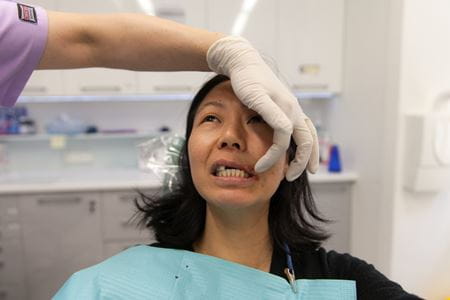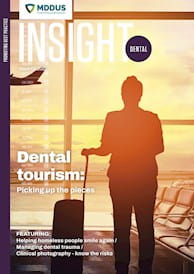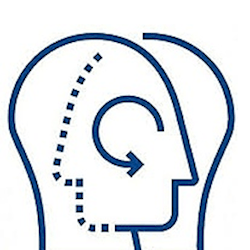 THE management of dental trauma is often untimely, unexpected and unnerving for both the patient and the dentist. These unfortunate events can happen to people with excellent dental health who may have never before needed any invasive treatment. Difficult decisions often have to be made quickly to ensure the best outcome.
THE management of dental trauma is often untimely, unexpected and unnerving for both the patient and the dentist. These unfortunate events can happen to people with excellent dental health who may have never before needed any invasive treatment. Difficult decisions often have to be made quickly to ensure the best outcome.
Despite these challenges, presence of mind from both the patient and the clinician are crucial to improve outcomes in the long term. Foresight is a friend in these circumstances.
Consent
Obtaining consent before starting treatment is a pre-requisite for managing dental trauma. But with time a crucial factor, the challenge for the dentist is to swiftly assess the teeth while helping a potentially distressed patient contemplate and reflect on the information provided.
Due to the unknowns of future healing and stabilisation, the patient should be made aware of the risk of failure and the possible need for extraction or root canal treatment. In addition, mentioning the need for short and long-term maintenance, from removal of the splint to radiographic follow-up years in the future, should be recorded.
Communication
Patients presenting with dental trauma may be in a state of shock and bewilderment, so the first step must be to rule out any significant head injuries. Once this is established, the dentist can then focus on the history and the patient’s current mental state. It is best to have an open supportive conversation with regards to the history, while being sensitive to the acute post-traumatic stress the patient may be under.
Be open and up front with the patient about any ‘bad news’ – such as the need for extractions or root canal treatment – but be sure to communicate this in a sensitive way. Depending on the nature, circumstances and aetiology of the injuries, it may be appropriate to suggest the patient seeks some kind of psychological support to aide progress throughout dental treatment.
Patient assessment
An important aspect of management is recording the injury and comparison with the previous presentation. This may not be always possible if the dentist is seeing the patient for the first time. Previous photographs of the patient’s smile, such as that on ‘selfies’, can provide invaluable information on tooth positioning.
As a standard, radiographs in at least two angulations, such as long cone periapical and upper standard occlusal, will also help to detect root or alveolar fractures.
Other aspects include the need to account for any fragments recovered from the scene of the accident and the presence or absence of avulsed units that may possibly be replanted or indeed inhaled. Where tooth fragments are not accounted for and soft tissue injuries are present, soft tissue radiographs can aide location.
In a patient with multiple injuries, the clinician should take a systematic approach to examining the occlusion and special tests to piece together and account for all injuries. In the more extreme presentation a cone-beam computed tomography (CBCT) could be an additional tool that may identify further injuries.
Unrestorable tooth units or those with a poor prognosis
Where units present with severe trauma, avoid extracting these where possible, especially if prognosis of all teeth has yet to be realised. The patient has just suffered a significant life event and being told they need to have teeth removed may bring upon further grief.
Delaying extraction also helps maintain bone until a more definitive treatment plan can be established once the acute phase is over. A long delay between extraction and implant provision will result in a residual alveolus with greater resorption and potentially further co-morbidities in managing this, such as grafting.
Tooth repositioning
Once the nature and the magnitude of the injuries are established, luxation injuries (disruption to the ligaments and tissues holding the tooth in place) can be considered for repositioning under local anaesthetic.
As mentioned earlier, it can be useful to refer to previous photos of the patient to get an idea of the tooth’s original position and an aim for the repositioning process. Where injuries present late, the ability to reposition reduces due to clot formation within the socket. In these circumstances compromise in position may have to be accepted pragmatically with subsequent occlusal adjustment if required.
Once repositioned, teeth should be splinted using resin composite and 0.018” stainless steel wire with at least one un-traumatised tooth adjacent to the injured units. This may be difficult to achieve, especially if there are soft tissue injuries such as lip lacerations adjacent, but ultimately should be made to be as cleansable as possible during the splint period to reduce any plaque-associated disease.
Pulpal management
Where the pulp is exposed, efforts should be made to maintain vitality through techniques such as the Cvek pulpotomy. Explain to the patient that there may still be a need for future root canal treatment despite best efforts.
Where fractures involve the root and there are multiple injuries, optimal isolation with rubber dam may be challenging. In these situations, consider a localised gingivectomy to gain clamp stabilisation.
Long-term follow-up
Despite best efforts, trauma-related pathology may only be revealed over the course of many years, hence the need for follow-up to identify changes such as loss of vitality and the need for root canal treatment.
Other more extensive issues, such as ankylosis or extensive root resorption, require remedial treatment that is more involved and may need specialist input and management. It may be best to manage these issues in the established adult dentition where maxillary growth is complete and gingival maturity has been realised, rather than in a growing adolescent.
The majority of trauma injuries occur in the young, so it is important to think ahead in terms of future consequences. Any restorations will need to be replaced more often over the course of the patient’s lifetime than if they were provided in adults in their 30s or older. This is especially true where maintaining the natural dentition or restorations without the need for implants provides scope for future options without exhausting a process which has greater morbidity and risk of complications.
Aws Alani is a consultant in the Restorative Dentistry and Traumatology Unit at Kings College Hospital, and course director for Kings College London’s Diploma in Operative Dentistry. Read more on his website: www.restorativedentistry.org
Further information
- Adult dental trauma: What should the dental practitioner know? Chauhan et al. 2016, article in Primary Dental Journal
- Dental Trauma at a Glance, a book by Aws Alani and Gareth Calvert. Available on Amazon.
This page was correct at the time of publication. Any guidance is intended as general guidance for members only. If you are a member and need specific advice relating to your own circumstances, please contact one of our advisers.
Read more from this issue of Insight Dental

Save this article
Save this article to a list of favourite articles which members can access in their account.
Save to library

